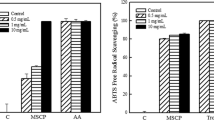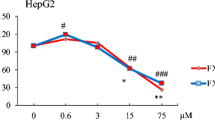Abstract
Oxidative stress is regarded as one of the most important factors associated with many diseases, such as atherosclerosis, cancer, and diabetes. Various chemicals are released into the environment, causing environmental pollution. Importantly, many of them may cause damage to organisms through oxidative stress. In this work, we investigated the possible protective effects of Nile tilapia (Oreochromis niloticus) scale collagen hydrolysate (TSCH) (molecular weight approximately 4 kDa) against tributyltin (TBT)-induced oxidative stress in vitro. The results showed that pretreatment with TSCH protected against decreases in cell viability and changes in cell morphology in HepG2 cells exposed to TBT. Treatment with TSCH reduced the TBT-induced elevation in malondialdehyde (MDA) levels in HepG2 cells in a dose-dependent manner. Pretreatment with TSCH increased glutathione reductase (GR) and superoxide dismutase (SOD) activity. Moreover, TSCH decreased the expression of the proapoptotic protein Bax, reducing apoptosis. These results suggest that the protective mechanism of TSCH may be associated with its ability to scavenge MDA, increase antioxidant enzyme activity and downregulate the expression of Bax.






Similar content being viewed by others
References
Ahn CB, Je JY, Cho YS (2012) Antioxidant and anti-inflammatory peptide fraction from salmon byproduct protein hydrolysates by peptic hydrolysis. Food Res Int 49:92–98
Ahn CB, Kim JG, Je JY (2014) Purification and antioxidant properties of octapeptide from salmon byproduct protein hydrolysate by gastrointestinal digestion. Food Chem 147:78–83
Al-Gubory KH (2014) Environmental pollutants and lifestyle factors induce oxidative stress and poor prenatal development. Reprod BioMed Online 29:17–31
Antizar-Ladislao B (2008) Environmental levels, toxicity and human exposure to tributyltin (TBT)-contaminated marine environment. A review Environ Int 34:292–308
Barange M, Merino G, Blanchard JL, Scholtens J, Harle J, Allison EH, Allen JI, Holt J, Jennings S (2014) Impacts of climate change on marine ecosystem production in societies dependent on fisheries. Nat Clim Chang 4:211–216
Bhattacharyya A, Chattopadhyay R, Mitra S, Crowe SE (2014) Oxidative stress: an essential factor in the pathogenesis of gastrointestinal mucosal diseases. Physiol Rev 94:329–354
Blanco M, Vázquez JA, Pérez-Martín RI, Sotelo CG (2017) Hydrolysates of fish skin collagen: an opportunity for valorizing fish industry byproducts. Mar Drugs 15:131
Celep E, Aydın A, Kırmızıbekmez H, Yesilada E (2013) Appraisal of in vitro and in vivo antioxidant activity potential of cornelian cherry leaves. Food Chem Toxicol 62:448–455
Chen YW, Lan KC, Tsai JR, Weng TI, Yang CY, Liu SH (2017) Tributyltin exposure at noncytotoxic doses dysregulates pancreatic β-cell function in vitro and in vivo. Arch Toxicol 91:1–10
Czabotar PE, Lessene G, Strasser A, Adams JM (2014) Control of apoptosis by the Bcl-2 protein family: implications for physiology and therapy. Nat Rev Mol Cell Biol 15:49–63
Duan X, Ocen D, Wu F, Li M, Yang N, Xu J, Chen H, Huang L, Jin Z, Xu X (2014) Purification and characterization of a natural antioxidant peptide from fertilized eggs. Food Res Int 56:18–24
Farvin KS, Andersen LL, Nielsen HH, Jacobsen C, Jakobsen G, Johansson I, Jessen F (2014) Antioxidant activity of cod (Gadus morhua) protein hydrolysates: in vitro assays and evaluation in 5% fish oil-in-water emulsion. Food Chem 149:326–334
García-Nebot MJ, Recio I, Hernández-Ledesma B (2014) Antioxidant activity and protective effects of peptide lunasin against oxidative stress in intestinal Caco-2 cells. Food Chem Toxicol 65:155–161
Gennari A, Viviani B, Galli CL, Marinovich M, Pieters R, Corsini E (2000) Organotins induce apoptosis by disturbance of [Ca2+]i and mitochondrial activity, causing oxidative stress and activation of caspases in rat thymocytes. Toxicol Appl Pharm 169:185–190
Ghassem M, Arihara K, Mohammadi S, Sani NA, Babji AS (2017) Identification of two novel antioxidant peptides from edible bird's nest (Aerodramus fuciphagus) protein hydrolysates. Food Funct 8:2046–2052
Girgih AT, He R, Hasan FM, Udenigwe CC, Gill TA, Aluko RE (2015) Evaluation of the in vitro antioxidant properties of a cod (Gadus morhua) protein hydrolysate and peptide fractions. Food Chem 173:652–659
Graceli JB, Sena GC, Lopes PF, Zamprogno GC, Da CM, Godoi AF, Dos Santos DM, de Marchi MR, Ma DSF (2013) Organotins: a review of their reproductive toxicity, biochemistry, and environmental fate. Reprod Toxicol 36:40–52
Huang CF, Yang CY, Tsai JR, Wu CT, Liu SH, Lan KC (2018) Low-dose tributyltin exposure induces an oxidative stress-triggered JNK-related pancreatic β-cell apoptosis and a reversible hypoinsulinemic hyperglycemia in mice. Sci Rep 8:5734
Ishihara Y, Fujitani N, Kawami T, Adachi C, Ishida A, Yamazaki T (2014) Suppressive effects of 17beta-estradiol on tributyltin-induced neuronal injury via Akt activation and subsequent attenuation of oxidative stress. Life Sci 99:24–30
Liang R, Zhang Z, Lin S (2017) Effects of pulsed electric field on intracellular antioxidant activity and antioxidant enzyme regulating capacities of pine nut (Pinus koraiensis) peptide QDHCH in HepG2 cells. Food Chem 237:793–802
Lima CF, Fernandesferreira M, Pereirawilson C (2006) Phenolic compounds protect HepG2 cells from oxidative damage: relevance of glutathione levels. Life Sci 79:2056–2068
Lin S, Liang R, Li X, Xing J, Yuan Y (2016) Effect of pulsed electric field (PEF) on structures and antioxidant activity of soybean source peptides-SHCMN. Food Chem 213:588–594
Liu J, Chen Z, He J, Zhang Y, Zhang T, Jiang Y (2014) Anti-oxidative and anti-apoptosis effects of egg white peptide, Trp-Asn-Trp-Ala-Asp, against H2O2-induced oxidative stress in human embryonic kidney 293 cells. Food Funct 5:3179–3188
Malomo SA, Onuh JO, Girgih AT, Aluko RE (2015) Structural and antihypertensive properties of enzymatic hemp seed protein hydrolysates. Nutrients 7:7616–7632
Maqbool F, Mostafalou S, Bahadar H, Abdollahi M (2016) Review of endocrine disorders associated with environmental toxicants and possible involved mechanisms. Life Sci 145:265–273
Meng D, Zhang P, Zhang L, Wang H, Ho CT, Li S, Shahidi F, Zhao H (2017) Detection of cellular redox reactions and antioxidant activity assays. J Funct Foods 37:467–479
Mitra S, Gera R, Siddiqui WA, Khandelwal S (2013b) Tributyltin induces oxidative damage, inflammation and apoptosis via disturbance in blood-brain barrier and metal homeostasis in cerebral cortex of rat brain: an in vivo and in vitro study. Toxicology 310:39–52
Mitra S, Srivastava A, Khandelwal S (2013a) Tributyltin chloride induced testicular toxicity by JNK and p38 activation, redox imbalance and cell death in sertoli-germ cell co-culture. Toxicology 314:39–50
Nazeer RA, Kumar NS, Ganesh RJ (2012) In vitro and in vivo studies on the antioxidant activity of fish peptide isolated from the croaker (Otolithes ruber) muscle protein hydrolysate. Peptides 35:261–268
Nordberg J, Arner ES (2001) Reactive oxygen species, antioxidants, and the mammalian thioredoxin system. Free Radical Bio Med 31:1287–1312
Pisoschi AM, Pop A (2015) The role of antioxidants in the chemistry of oxidative stress: a review. Eur J Med Chem 97:55–74
Ray PD, Huang BW, Tsuji Y (2012) Reactive oxygen species (ROS) homeostasis and redox regulation in cellular signaling. Cell Signal 24:981–990
Saidi S, Deratani A, Belleville M-P, Amar RB (2014) Antioxidant properties of peptide fractions from tuna dark muscle protein by-product hydrolysate produced by membrane fractionation process. Food Res Int 65:329–336
Soboń A, Szewczyk R, Długoński J (2016) Tributyltin (TBT) biodegradation induces oxidative stress of Cunninghamella echinulata. Int Biodeter Biodegr 107:92–101
Sudhakar S, Nazeer RA (2015) Structural characterization of an Indian squid antioxidant peptide and its protective effect against cellular reactive oxygen species. J Funct Foods 14:502–512
Tang CH, Chihsin H, Wang WH (2010) Butyltin accumulation in marine bivalves under field conditions in Taiwan. Mar Environ Res 70:125–132
Théolier J, Hammami R, Labelle P, Fliss I, Jean J (2013) Isolation and identification of antimicrobial peptides derived by peptic cleavage of whey protein isolate. J Funct Foods 5:706–714
Torres-Fuentes C, Contreras MDM, Recio I, Alaiz M, Vioque J (2015) Identification and characterization of antioxidant peptides from chickpea protein hydrolysates. Food Chem 180:194–202
Volk APD, Moreland JG (2014) ROS-containing endosomal compartments: implications for signaling. Method Enzymol 535:201–224
Wang L, Ding L, Yu Z, Zhang T, Ma S, Liu J (2016) Intracellular ROS scavenging and antioxidant enzyme regulating capacities of corn gluten meal-derived antioxidant peptides in HepG2 cells. Food Res Int 90:33–41
Wattanasiritham L, Theerakulkait C, Wickramasekara S, Maier CS, Stevens JF (2016) Isolation and identification of antioxidant peptides from enzymatically hydrolyzed rice bran protein. Food Chem 192:156–162
Whalen MM, Loganathan BG, Kannan K (1999) Immunotoxicity of environmentally relevant concentrations of butyltins on human natural killer cells in vitro. Environ Res 81:108–116
Winterbourn CC (2014) The challenges of using fluorescent probes to detect and quantify specific reactive oxygen species in living cells. Bba-Gen Subjects 1840:730–738
Yarnpakdee S, Benjakul S, Kristinsson HG, Bakken HE (2015) Preventive effect of Nile tilapia hydrolysate against oxidative damage of HepG2 cells and DNA mediated by H2O2 and AAPH. J Food Sci Technol 52:6194–6205
Zeng J, Zhang Y, Ruan J, Yang Z, Wang C, Hong Z, Zuo Z (2018) Protective effects of fucoxanthin and fucoxanthinol against tributyltin-induced oxidative stress in HepG2 cells. Environ Sci Pollut Res 25:5582–5589
Zeng WC, Sun Q, Zhang WH, Liao X-P, Shi B (2017) Antioxidant activity in vivo and biological safety evaluation of a novel antioxidant peptide from bovine hair hydrolysates. Process Biochem 56:193–198
Zhang Y, Chen Y, Sun L, Liang J, Guo Z, Xu L (2014) Protein phosphatases 2A as well as reactive oxygen species involved in tributyltin-induced apoptosis in mouse livers. Environ Toxicol 29:234–242
Zhou M, Feng M, Fu LL, Ji LD, Zhao JS, Xu J (2016) Toxicogenomic analysis identifies the apoptotic pathway as the main cause of hepatotoxicity induced by tributyltin. Food Chem Toxicol 97:316–326
Funding
This work was supported by the Ocean Public Welfare Scientific Research Special Appropriation Project (201405017), the Major State Basic Research Development Program of China (Grant Nos. 2017YFA0205201), and the Natural Science Foundation of Fujian Province of China (No. 2018 J01067).
Author information
Authors and Affiliations
Corresponding authors
Ethics declarations
Conflict of interest
The authors declare that they have no competing interests.
Additional information
Responsible editor: Philippe Garrigues
Electronic supplementary material
ESM 1
(DOCX 14 kb)
Rights and permissions
About this article
Cite this article
Ruan, J., Chen, J., Zeng, J. et al. The protective effects of Nile tilapia (Oreochromis niloticus) scale collagen hydrolysate against oxidative stress induced by tributyltin in HepG2 cells. Environ Sci Pollut Res 26, 3612–3620 (2019). https://doi.org/10.1007/s11356-018-3729-9
Received:
Accepted:
Published:
Issue Date:
DOI: https://doi.org/10.1007/s11356-018-3729-9




